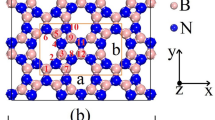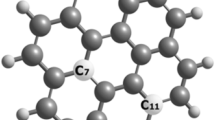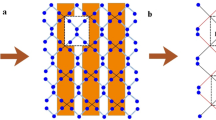Abstract
In this paper, a pioneering study of the electronic and optical properties of QPHT-graphene after adsorbing three types of alkali metal atoms (Li/Na/K) was conducted using first-principles calculations based on density functional theory. The electronic properties study covers TDOS, PDOS, and Bader charge analyses, in addition to charge density difference. The optical properties study considers the complex dielectric function, complex refractive function, absorption coefficient, reflection coefficient and energy loss function under three types of polarization. The results show that all configurations exhibit a good optical response within a wide energy range of 0–25 eV and are anisotropic under all three polarization types. Under \(E_{x}\) and \(E_{y}\) polarizations, the adsorption of alkali metal atoms significantly enhances the absorptivity, reflectivity, and refractivity of the pristine QPHT-graphene. As the atomic number increases, it shows a regular oscillatory behavior. Under \(E_{z}\) polarization, the QPHT-graphene optical response is concentrated in the high-frequency ultraviolet region, i.e., higher than 10 eV, and alkali metal atom adsorption has little effect on its optical properties. These results show that alkali metal atom adsorption can effectively modulate the optical properties of QPHT-graphene. This research can help to further understand the electronic and optical properties of QPHT-graphene and is instructive in promoting the application of new two-dimensional nanocarbon materials in the field of optoelectronics.
Graphic abstract










Similar content being viewed by others
Data Availability Statement
This manuscript has no associated data or the data will not be deposited. [Authors’ comment: There is no data in this article, all results have been shared in the publication.]
References
M.J. Allen, V.C. Tung, R.B. Kaner, Honeycomb carbon: a review of graphene. Chem. Rev. 110(1), 132–145 (2010)
R. Nandkishore, L.S. Levitov, A.V. Chubukov, Chiral superconductivity from repulsive interactions in doped graphene. Nat. Phys. 8(2), 158–163 (2012)
S. Caterina, M. Ather, D. Erik, Production, properties and potential of graphene. Carbon 48(8), 2127–2150 (2010)
G.F. Luo, X.M. Qian, H.B. Liu, R. Qiu, J. Zhou, Quasiparticle energies and excitonic effects of the two-dimensional carbon allotrope graphdiyne: theory and experiment. Phys. Rev. B 84(7), 075439 (2011)
O.V. Yazyev, Y.P. Chen, Polycrystalline graphene and other two-dimensional materials. Nat. Nanotechnol. 9(10), 755–767 (2014)
Y. Gao, Y.P. Chen, C. Zhong, Z. Zhang, Y. Xie, S. Zhang, Electron and phonon properties and gas storage in carbon honeycomb. Nanoscale 8(26), 12863 (2016)
Y.Q. Sun, Q. Wu, G.Q. Shi, Graphene based new energy materials. Energy Environ. Sci. 4(4), 1113–1132 (2011)
A.K. Geim, K.S. Novoselov, The rise of graphene. Nanosci. Technol. 11–19 (2010)
A.K. Geim, Graphene: status and prospects. Science 324(5934), 1530–1534 (2009)
S.H. Zhang, J. Zhou, J. Puru, Penta-graphene: a new carbon allotrope. Proc. Natl. Acad. Sci. USA 112(8), 2372–2377 (2015)
B. Xiao, Y. Li, X. Yu, J. Cheng, Penta-graphene: a promising anode material as the Li/Na-ion battery with both extremely high theoretical capacity and fast charge = discharge rate. ACS Appl. Mater. Interfaces 8(51), 35342–35352 (2016)
Z. Wang, X. Zhou, X. Zhang, Q. Zhu, H. Dong, M. Zhao, A.R. Oganov, Phagraphene: a low-energy graphene allotrope composed of 567 Carbon rings with distorted dirac cones. Nano Lett. 15(9), 6182–6186 (2015)
J.W. Jiang, J.T. Leng, J.X. Li, Z.R. Guo, T.C. Chang, X.M. Guo, T.Y. Zhang, Twin graphene: a novel two-dimensional semiconducting carbon allotrope. Carbon 118, 370–375 (2017)
S. Wang, B. Yang, H. Chen, E. Ruckenstein, Popgraphene: a new 2D planar carbon allotrope composed of 585 carbon rings for high-performance lithiumion battery anodes from bottom-up programming. J. Mater. Chem. A 6(15), 6687–6687 (2018)
S. Thomas, C.H. Lee, S. Jana, B. Jun, S.U. Lee, Phographene as a high-performance anode material with high specific capacity and fast Li diffusion: from structural, electronic, and mechanical properties to LIB applications. J. Phys. Chem. C 123(35), 21345–21352 (2019)
Y. Shen, J. Yu, J. Liu, Y. Guo, Y. Qie, Q. Wang, PCF-graphene: a 2D sp2-hybridized carbon allotrope with a direct band gap. J. Phys. Chem. C 123(7), 4567–4573 (2019)
X. Wang, L. Chen, Z. Yuan, J. Rong, J. Feng, I. Muzammil, X. Yu, Y. Zhang, Z. Zhan, DHQ-graphene: a novel two-dimensional defective graphene for corrosion-resistant coating. J. Mater. Chem. A 7(15), 8967–8974 (2019)
C. Kou, Y. Tian, M. Zhang, E. Zurek, X. Qu, X. Wang, K. Yin, Y. Yan, L. Gao, M. Lu et al., M-graphene: a metastable two-dimensional carbon allotrope. 2D Mater. 7(2), 025047 (2020)
X.Y. Li, W. Qian, J. Puru, Graphene: a new metallic allotrope of planar carbon with potential applications as anode materials for lithium-ion batteries. J. Phys. Chem. Lett. 8(14), 3234–3241 (2017)
G.L. Liang, C.Y. He, X. Wang, L.Z. Sun, P. Zhou, Dirac semimetal protected by nonsymmorphic mirror symmetries in TPH-graphene. Phys. Status Solidi Rapid Res. Lett. 15(7), 2100039 (2021)
X.M. Zhang, L. Wei, J. Tan, M.W. Zhao, Prediction of an ultrasoft graphene allotrope with Dirac cones. Carbon 105, 323–329 (2016)
B.T. Kang, J.Y. Lee, Electronic properties of \(\alpha \)-graphyne nanotubes. Carbon 84, 246–253 (2015)
W.X. Zhou, K.Q. Chen, Enhancement of thermoelectric performance in \(\beta \)-graphyne nanoribbons by suppressing phononic thermal conductance. Carbon 85, 24–27 (2015)
X. Wang, J. Rong, Y. Song, X. Yu, Z. Zhan, J. Deng, QPHT-graphene: a new two-dimensional metallic carbon allotrope. Phys. Lett. A 381(34), 2845–2849 (2017)
B. Li, Z.G. Shao, Y.T. Feng, Electronic and optical properties of pristine and Li/Na/K/Mg/Ca decorated net-Y: first-principles calculations. Mater. Sci. Eng. B 271, 115269 (2021)
P.E. Blchl, Projector augmented-wave method. Phys. Rev. B 50(24), 17953–17979 (1994)
G. Kresse, J. Furthmller, Efficient iterative schemes for ab initio total-energy calculations using a plane-wave basis set. Phys. Rev. B 54(16), 11169–11186 (1996)
G. Kresse, D. Joubert, From ultrasoft pseudopotentials to the projector augmented-wave method. Phys. Rev. B 59(3), 1758–1775 (1999)
J.P. Perdew, K. Burke, M. Ernzerhof, Generalized gradient approximation made simple. Phys. Rev. Lett. 77(18), 3865–3868 (1996)
G.S.L. Fabris, A.R. Albuquerque, R. Dovesi, J.R. Sambrano, A promising carbon-based nanosheet as a suitable Na-anode material. Mater. Sci. Eng. B 268, 115121 (2021)
V. Wang, N. Xu, J. Liu, G. Tang, W. Geng, Vaspkit: a user-friendly interface facilitating high-throughput computing and analysis using VASP code. Comput. Phys. Commun. 267, 108033 (2021)
F. Wooten, Optical properties of solids. Am. J. Phys. 41(7), 939–940 (1973)
M. Dressel, G. Gruener, G.F. Bertsch, Electrodynamics of solids: optical properties of electrons in matter. Am. J. Phys. 70(12), 1269–1270 (2002)
Acknowledgements
This work was supported by the National Natural Science Foundation of China (Grant no. 52072132).
Author information
Authors and Affiliations
Contributions
T-CQ: writing—original draft, data curation. Z-GS: writing—review and editing, supervision, conceptualization. C-LW: writing—review and editing, conceptualization. LY: writing—review and editing.
Corresponding authors
Ethics declarations
Conflict of interest
The authors declare that they have no known competing financial interests or personal relationships that could have appeared to influence the work reported in this paper.
Supplementary Information
Below is the link to the electronic supplementary material.
Rights and permissions
Springer Nature or its licensor (e.g. a society or other partner) holds exclusive rights to this article under a publishing agreement with the author(s) or other rightsholder(s); author self-archiving of the accepted manuscript version of this article is solely governed by the terms of such publishing agreement and applicable law.
About this article
Cite this article
Qiu, TC., Shao, ZG., Wang, CL. et al. Electronic and optical properties of pristine and alkali metal atom-adsorbed QPHT-graphene: first-principles calculations. Eur. Phys. J. B 96, 103 (2023). https://doi.org/10.1140/epjb/s10051-023-00572-5
Received:
Accepted:
Published:
DOI: https://doi.org/10.1140/epjb/s10051-023-00572-5




